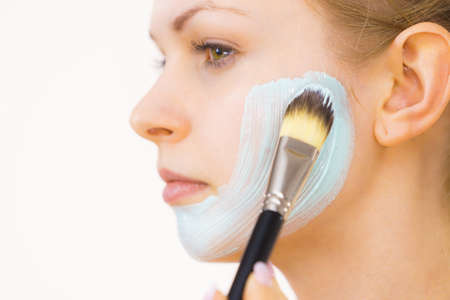What Are Clay Masks?
Clay masks have been a skincare staple for centuries, with their roots tracing back to ancient civilizations like Egypt and Rome. Today, they remain a favorite in American beauty routines, thanks to their natural origins and impressive skin benefits. In the U.S., the most popular types of clay used in masks include bentonite, kaolin, and French green clay—each offering unique properties tailored to different skin concerns. But what exactly makes clay masks so effective? The science lies in their ability to absorb excess oil, draw out impurities, and gently exfoliate dead skin cells. As the clay dries on your skin, it binds to dirt and toxins, making them easy to wash away. This simple yet powerful mechanism is why so many people turn to clay masks for clearer, healthier-looking skin.
Key Benefits of Using Clay Masks
Clay masks have become a staple in American skincare routines, and for good reason. These masks offer a wide range of benefits that go far beyond the hype. Whether you’re battling oily skin, clogged pores, or the occasional breakout, clay masks can be your go-to solution. Let’s break down the real perks you’ll experience when you add clay masks to your self-care regimen.
Detoxifies and Purifies Pores
One of the biggest reasons people love clay masks is their ability to draw out impurities from deep within the pores. Thanks to their natural absorbent properties, clays like bentonite and kaolin act like magnets for dirt, oil, and environmental toxins. This leaves your skin feeling fresher and looking clearer after just one use.
Controls Oil and Shine
If you struggle with excess shine, especially on your T-zone, clay masks can help balance things out. By absorbing excess sebum, these masks prevent clogged pores and reduce unwanted sheen without over-drying your skin.
| Skin Concern | How Clay Masks Help |
|---|---|
| Oily Skin | Absorb excess oil and minimize shine |
| Clogged Pores | Remove impurities and deep-cleanse pores |
| Irritated Skin | Soothe redness and calm inflammation |
| Dull Complexion | Refresh skin for a healthy glow |
Soothes Irritated Skin
Certain types of clay—like French green or pink clay—are rich in minerals that calm redness and irritation. If your skin feels stressed from harsh weather or too many products, a gentle clay mask can restore comfort without adding extra chemicals.
Gentle Exfoliation for Smoother Texture
While not as abrasive as some scrubs, clay masks provide mild exfoliation by lifting away dead skin cells as they dry. This helps reveal a smoother, more even complexion over time.
The Bottom Line: Multi-Tasking Marvels
No matter your skin type, there’s likely a clay mask that fits your needs. From detoxifying and oil control to soothing sensitive areas, these masks offer a customizable way to upgrade your skincare game—all in under 20 minutes per session.

3. Busting Common Myths About Clay Masks
When it comes to clay masks, there’s no shortage of myths floating around—especially in the U.S., where skincare trends come and go in a flash. Let’s clear up some of the most common misconceptions Americans might have about these skincare staples.
Myth #1: Clay Masks Are Only for Oily Skin
This is probably the biggest myth out there. While clay masks are known for their oil-absorbing properties, not all clays are created equal. There are gentler clays like kaolin that can benefit dry or sensitive skin by gently detoxifying without stripping away moisture. If you have combination or even dry skin, don’t shy away—just choose a formula that fits your needs.
Myth #2: All Clays Work the Same Way
It’s easy to lump all clay masks together, but different types of clay serve different purposes. Bentonite clay is great for deep cleansing and controlling excess oil, while French green clay helps with mild exfoliation and tightening pores. Kaolin is softer and suited for those with delicate or easily irritated skin. Understanding which clay works best for your skin type makes all the difference.
Myth #3: You Should Let Your Clay Mask Dry Completely
Many people think you need to wait until your face feels tight and cracked before rinsing off a clay mask. In reality, letting it dry completely can actually dehydrate your skin and cause irritation. The best practice? Rinse off once the mask starts to lighten in color but still feels slightly damp to the touch.
Myth #4: You’ll See Instant Results Every Time
While some people experience immediate benefits like reduced shine or smoother texture, real transformation takes consistency. Don’t be discouraged if your first use doesn’t give you flawless results—stick with it and watch how your skin improves over time.
Busting These Myths Leads to Better Skincare Choices
By understanding what clay masks can—and can’t—do, you’ll be able to pick products that truly work for your unique skin. Remember: knowledge is power when it comes to self-care!
4. How to Use Clay Masks the Right Way
Step-by-Step Guide for Proper Application
- Start with a Clean Slate: Wash your face with a gentle cleanser to remove makeup, dirt, and oil. Pat your skin dry with a clean towel.
- Apply Evenly: Using clean fingers or a mask brush, spread an even layer of clay mask over your face, avoiding the eye and lip areas.
- Wait, But Don’t Overdo It: Let the mask sit according to the product instructions—usually 10–15 minutes. The mask should feel slightly dry but not uncomfortably tight or cracking.
- Rinse Off Gently: Use lukewarm water and a soft washcloth or just your hands to rinse off the mask thoroughly.
- Follow Up: Immediately apply a gentle moisturizer to restore hydration and keep your skin balanced.
How Often Should You Use Clay Masks?
| Skin Type | Recommended Frequency |
|---|---|
| Oily/Acne-Prone | 2–3 times per week |
| Normal/Combination | 1–2 times per week |
| Dry/Sensitive | Once per week or less (patch test first) |
Integrating Clay Masks Into Your American Skincare Routine
If you follow the typical American skincare routine—cleanser, toner, serum, moisturizer, and sunscreen—clay masks can fit in as a weekly or biweekly treatment after cleansing and before applying other products. Avoid layering harsh exfoliants or retinoids on the same night as your mask to prevent irritation. Instead, treat yourself to a clay mask during your “self-care Sunday” or as a midweek reset for clearer, smoother skin. Consistency is key: stick to the recommended frequency based on your skin type and always listen to how your skin responds.
5. Choosing the Best Clay Mask for Your Skin Type
Not all clay masks are created equal, and picking the right one can make a world of difference for your skin’s health and appearance. Here are some tips to help you find the perfect match, plus recommendations tailored to different skin types and concerns.
Know Your Skin Type
Before adding any clay mask to your routine, it’s crucial to understand your skin type. Are you oily, dry, combination, sensitive, or acne-prone? Each type will benefit from different ingredients and formulations.
For Oily or Acne-Prone Skin
If you struggle with excess oil or frequent breakouts, opt for masks featuring bentonite or kaolin clay. These clays are superstar absorbers—they help soak up sebum and clear out clogged pores without being overly harsh. Look for products that mention “purifying,” “oil control,” or “clarifying” on their labels.
For Dry or Sensitive Skin
If your skin tends to feel tight, flaky, or easily irritated, go for gentler options like pink clay or white kaolin. These clays offer mild detoxification without stripping essential moisture. Choose formulas that include hydrating ingredients like aloe vera, chamomile, or hyaluronic acid to give your skin a soothing boost.
For Combination Skin
Combination skin can be tricky, so multi-masking is your friend—use a mattifying clay (like green clay) on your T-zone and a more hydrating formula on your cheeks. Alternatively, choose balanced masks labeled “for all skin types” that combine several clays and nourishing extracts.
Additional Tips
- Always read ingredient lists to avoid allergens or irritants.
- Patch test new products before applying them to your entire face.
- If you’re targeting specific issues (like redness, dullness, or uneven texture), look for added actives such as vitamin C, niacinamide, or licorice root extract.
Pro Tip:
Don’t be afraid to ask for samples at beauty stores or consult with a dermatologist if you’re unsure which mask suits you best. Remember—when it comes to skincare, personalization is key!
6. Dos and Don’ts for Clay Mask Success
If you want to get the most out of your clay mask routine, it’s important to follow a few key dos and don’ts. Applying a clay mask isn’t rocket science, but making small mistakes can leave your skin feeling tight or irritated. Here’s how to keep your glow game strong without over-drying your skin.
Dos: Make the Most of Your Mask
Do: Prep Your Skin Properly
Start with a clean face—remove makeup and cleanse thoroughly. This helps the clay work its magic by drawing out impurities rather than just sitting on top of dirt or oil.
Do: Patch Test First
Even if you’ve used clay masks before, always patch test a new product on a small area of your skin. Everyone’s skin is different, and it’s better to be safe than sorry.
Do: Use the Right Tools
Apply your clay mask with clean fingers or a dedicated brush for an even layer. This avoids contamination and ensures smooth application.
Do: Listen to Your Skin
If you feel stinging, burning, or extreme tightness, rinse off immediately. A little tingling can be normal, but pain is not part of the process.
Don’ts: Common Mistakes to Avoid
Don’t: Leave It On Too Long
Letting your mask dry until it cracks may seem satisfying, but it can strip natural oils and leave your skin parched. Follow the recommended time (usually 10–15 minutes) for best results.
Don’t: Overuse Clay Masks
Aim for once or twice a week depending on your skin type. Daily use can disrupt your skin barrier, leading to dryness or irritation—nobody wants that!
Don’t: Skip Moisturizer Afterward
Your skin needs hydration after a deep cleanse. Always follow up with a good moisturizer to lock in softness and balance.
Pro Tip:
If you have combo or sensitive skin, try “multi-masking”—apply clay only where you need it (like your T-zone) and use a gentler hydrating mask elsewhere.
Nailing these dos and don’ts will help you harness all the benefits of clay masks—clearer pores, smoother texture, and that fresh-faced feeling—without unwanted side effects. Happy masking!

